Tp-link C60, AC1350 User Manual

Archer C60
User Guide
AC1350 Wireless Dual Band Router
REV1.0.0 1910011738
Contents
About This Guide................................................................................................ |
1 |
Chapter 1. Get to Know About Your Router. . . . . . . . . . . . . . . . . . . . . . . . . . 2
1. 1. Product Overview . . . . . . . . . . . . . . . . . . . . . . . . . . . . . . . . . . . . . . . . . . . . . . . . . . . . . . . . . . 3
1. 2. Panel Layout. . . . . . . . . . . . . . . . . . . . . . . . . . . . . . . . . . . . . . . . . . . . . . . . . . . . . . . . . . . . . . . . 3
1. 2. 1.Top View . . . . . . . . . . . . . . . . . . . . . . . . . . . . . . . . . . . . . . . . . . . . . . . . . . . . . . . . . . . . . 3
1. 2. 2.The Back Panel . . . . . . . . . . . . . . . . . . . . . . . . . . . . . . . . . . . . . . . . . . . . . . . . . . . . . . . 4
Chapter 2. Connect the Hardware . . . . . . . . . . . . . . . . . . . . . . . . . . . . . . . . . . 6
2. 1. Position Your Router . . . . . . . . . . . . . . . . . . . . . . . . . . . . . . . . . . . . . . . . . . . . . . . . . . . . . . . . 7
2. 2. Connect Your Router . . . . . . . . . . . . . . . . . . . . . . . . . . . . . . . . . . . . . . . . . . . . . . . . . . . . . . . . 7
Chapter 3. Log into Your Router . . . . . . . . . . . . . . . . . . . . . . . . . . . . . . . . . . .10 Chapter 4. Set Up Internet Connection. . . . . . . . . . . . . . . . . . . . . . . . . . . . .12
4. 1. Use Quick Setup Wizard . . . . . . . . . . . . . . . . . . . . . . . . . . . . . . . . . . . . . . . . . . . . . . . . . . . .13 4. 2. Manually Set up Your Internet Connection . . . . . . . . . . . . . . . . . . . . . . . . . . . . . . . . .13 4. 3. Set Up an IPv6 Internet Connection . . . . . . . . . . . . . . . . . . . . . . . . . . . . . . . . . . . . . . . .17
Chapter 5. Guest Network. . . . . . . . . . . . . . . . . . . . . . . . . . . . . . . . . . . . . . . . .21
5. 1. |
Create a Network for Guests . . . . . . . . . . . . . . . . . . . . . . . . . . . . . . . . . . . . . . . . . . . . . . . |
22 |
5. 2. |
Customize Guest Network Options . . . . . . . . . . . . . . . . . . . . . . . . . . . . . . . . . . . . . . . . . |
23 |
Chapter 6. Parental Controls . . . . . . . . . . . . . . . . . . . . . . . . . . . . . . . . . . . . . .24
Chapter 7. QoS . . . . . . . . . . . . . . . . . . . . . . . . . . . . . . . . . . . . . . . . . . . . . . . . . . .28
7. 1. Prioritize Internet Traffic with QoS . . . . . . . . . . . . . . . . . . . . . . . . . . . . . . . . . . . . . . . . . .29
Chapter 8. Network Security . . . . . . . . . . . . . . . . . . . . . . . . . . . . . . . . . . . . . .33
8. 1. Protect the Network from Cyber Attacks . . . . . . . . . . . . . . . . . . . . . . . . . . . . . . . . . . . .34 8. 2. Access Control . . . . . . . . . . . . . . . . . . . . . . . . . . . . . . . . . . . . . . . . . . . . . . . . . . . . . . . . . . . . .35 8. 3. IP & MAC Binding . . . . . . . . . . . . . . . . . . . . . . . . . . . . . . . . . . . . . . . . . . . . . . . . . . . . . . . . . .37
Chapter 9. NAT Forwarding . . . . . . . . . . . . . . . . . . . . . . . . . . . . . . . . . . . . . . .38
9. 1. Share Local Resources on the Internet by Virtual Servers . . . . . . . . . . . . . . . . . . . .39 9. 2. Open Ports Dynamically by Port Triggering . . . . . . . . . . . . . . . . . . . . . . . . . . . . . . . . .40 9. 3. Make Applications Free from Port Restriction by DMZ . . . . . . . . . . . . . . . . . . . . . . .41 9. 4. Make Xbox Online Games Run Smoothly by UPnP . . . . . . . . . . . . . . . . . . . . . . . . . . 42
Chapter 10.VPN Server . . . . . . . . . . . . . . . . . . . . . . . . . . . . . . . . . . . . . . . . . . . .44
10. 1. Use OpenVPN to Access Your Home Network . . . . . . . . . . . . . . . . . . . . . . . . . . . . . . .45 10. 2. Use PPTP VPN to Access Your Home Network . . . . . . . . . . . . . . . . . . . . . . . . . . . . . . .46
Chapter 11.Customize Your Network Settings. . . . . . . . . . . . . . . . . . . . . . .52
11. 1. Change the LAN Settings. . . . . . . . . . . . . . . . . . . . . . . . . . . . . . . . . . . . . . . . . . . . . . . . . . .53 11. 2. Configure to Support IPTV Service. . . . . . . . . . . . . . . . . . . . . . . . . . . . . . . . . . . . . . . . . .53 11. 3. Specify DHCP Server Settings . . . . . . . . . . . . . . . . . . . . . . . . . . . . . . . . . . . . . . . . . . . . . .55 11. 4. Set Up a Dynamic DNS Service Account . . . . . . . . . . . . . . . . . . . . . . . . . . . . . . . . . . . .56 11. 5. Create Static Routes. . . . . . . . . . . . . . . . . . . . . . . . . . . . . . . . . . . . . . . . . . . . . . . . . . . . . . . .57 11. 6. Specify Wireless Settings . . . . . . . . . . . . . . . . . . . . . . . . . . . . . . . . . . . . . . . . . . . . . . . . . . .59 11. 7. Use WPS for Wireless Connection . . . . . . . . . . . . . . . . . . . . . . . . . . . . . . . . . . . . . . . . . . .61
11. 7. 1.Set the Router’s PIN. . . . . . . . . . . . . . . . . . . . . . . . . . . . . . . . . . . . . . . . . . . . . . . . .61 11. 7. 2.Use the WPS Wizard for Wi-Fi Connections. . . . . . . . . . . . . . . . . . . . . . . . . . .61
Chapter 12.Manage the Router . . . . . . . . . . . . . . . . . . . . . . . . . . . . . . . . . . . .62
12. 1. Set Up System Time . . . . . . . . . . . . . . . . . . . . . . . . . . . . . . . . . . . . . . . . . . . . . . . . . . . . . . . .63 12. 2. Test the Network Connectivity . . . . . . . . . . . . . . . . . . . . . . . . . . . . . . . . . . . . . . . . . . . . .64 12. 3. Upgrade the Firmware . . . . . . . . . . . . . . . . . . . . . . . . . . . . . . . . . . . . . . . . . . . . . . . . . . . . .65 12. 3. 1.Online Upgrade . . . . . . . . . . . . . . . . . . . . . . . . . . . . . . . . . . . . . . . . . . . . . . . . . . . .66 12. 3. 2.Local Upgrade. . . . . . . . . . . . . . . . . . . . . . . . . . . . . . . . . . . . . . . . . . . . . . . . . . . . . .66 12. 3. 3.Restore Interrupted Upgrade after Power Failure . . . . . . . . . . . . . . . . . . . .67
12. 4. Backup and Restore Configuration Settings . . . . . . . . . . . . . . . . . . . . . . . . . . . . . . . . .67 12. 5. Change the Administrator Account . . . . . . . . . . . . . . . . . . . . . . . . . . . . . . . . . . . . . . . . .69 12. 6. Password Recovery . . . . . . . . . . . . . . . . . . . . . . . . . . . . . . . . . . . . . . . . . . . . . . . . . . . . . . . .69 12. 7. Local Management . . . . . . . . . . . . . . . . . . . . . . . . . . . . . . . . . . . . . . . . . . . . . . . . . . . . . . . .70 12. 8. Remote Management. . . . . . . . . . . . . . . . . . . . . . . . . . . . . . . . . . . . . . . . . . . . . . . . . . . . . .71 12. 9. System Log . . . . . . . . . . . . . . . . . . . . . . . . . . . . . . . . . . . . . . . . . . . . . . . . . . . . . . . . . . . . . . . .72 12. 10. Monitor the Internet Traffic Statistics . . . . . . . . . . . . . . . . . . . . . . . . . . . . . . . . . . . . . . .74 12. 11. Control LEDs. . . . . . . . . . . . . . . . . . . . . . . . . . . . . . . . . . . . . . . . . . . . . . . . . . . . . . . . . . . . . . .75
FAQ |
......................................................................................................................77 |

About This Guide
This guide is a complementation of Quick Installation Guide. The Quick Installation Guide instructs you on quick Internet setup, and this guide provides details of each function and shows you the way to configure these functions appropriate to your needs.
When using this guide, please notice that features of the router may vary slightly depending on the model and software version you have, and on your location, language, and Internet service provider. All screenshots, images, parameters and descriptions documented in this guide are used for demonstration only.
Conventions
In this guide the following conventions are used:
Convention |
Description |
|
Blue Italic |
Hyperlinks are in blue italic. You can click to redirect to a website or a specific section. |
|
|
|
|
Blue |
Contents to be emphasized and texts on the web page are in blue, including the |
|
menus, items, buttons, etc. |
||
|
The menu structures to show the path to load the corresponding page. For example,
>Advanced > Wireless > MAC Filtering means the MAC Filtering function page is under the Wireless menu that is located in the Advanced tab.
|
|
Note: |
Ignoring this type of note might result in a malfunction or damage to the device. |
|
|
|
|||
|
|
|
|
|
|
|
|
Tips: |
Indicates important information that helps you make better use of your device. |
|
|
|
||
|
|
|
||
|
• |
click to edit the corresponding entry. |
symbols on the web |
• |
click to delete the corresponding entry. |
page |
• click to enable or disable the corresponding entry. |
|
|
||
|
• |
click to view more information about items on the page. |
More Info
•The latest software, management app and utility can be found at Download Center at http://www.tp-link.com/support.
•The Quick Installation Guide (QIG) can be found where you find this guide or inside the package of the router.
•Specifications can be found on the product page at http://www.tp-link.com.
•A Technical Support Forum is provided for you to discuss our products at http://forum.tp-link.com.
•Our Technical Support contact information can be found at the Contact Technical Support page at http://www.tp-link.com/support.
1

Chapter 1
Get to Know About Your Router
This chapter introduces what the router can do and shows its appearance. This chapter contains the following sections:
•Product Overview
•Panel Layout
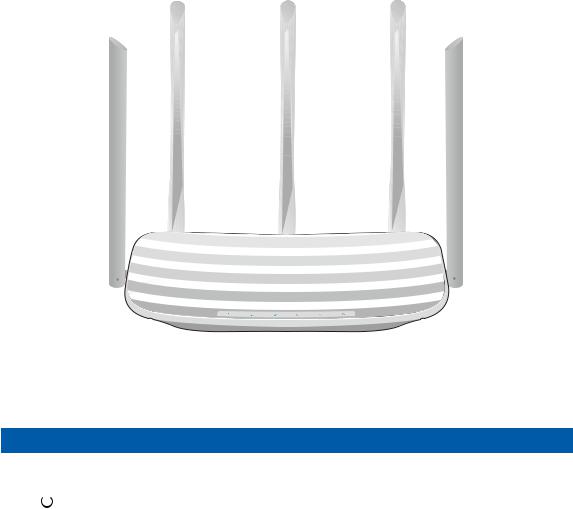
Chapter 1 |
Get to Know About Your Router |
1. 1. Product Overview
The TP-LINK router is designed to fully meet the need of Small Office/Home Office (SOHO) networks and the users demanding higher networking performance. The powerful antennas ensure continuous Wi-Fi signal to all your devices while boosting widespread coverage throughout your home, and the built-in Ethernet ports supply high-speed connection to your wired devices.
Moreover, it is simple and convenient to set up and use the TP-LINK router due to its intuitive web interface and the powerful Tether app.
1. 2. Panel Layout
1. 2. 1. Top View
The router’s LEDs (view from left to right) are located on the front panel. You can check the router’s working status by following the LED Explanation table.
LED Explanation
|
|
Name |
Status |
Indication |
|
|
|
On |
System initialization completes. |
|
|
|
|
|
|
|
(Power) |
Flashing |
System initialization or firmware upgrade is in process. Do not |
|
|
disconnect or power off the router. |
||
|
|
|
|
|
|
|
|
|
|
|
|
|
Off |
Power is off. |
|
|
|
|
|
3
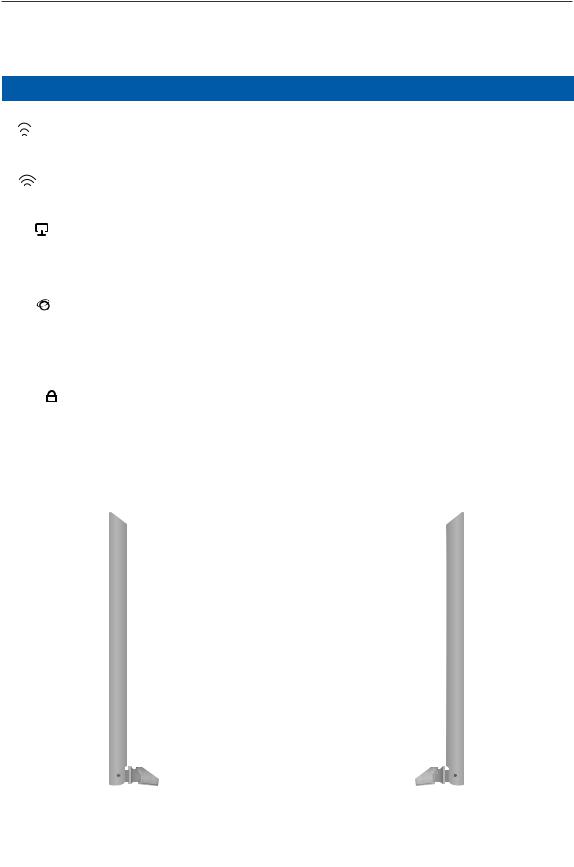
Chapter 1 Get to Know About Your Router
LED Explanation
Name |
Status |
Indication |
|
|
On |
The 2.4GHz wireless band is working properly. |
|
(2.4GHz Wireless) |
|
|
|
Off |
The 2.4 GHz wireless band is disabled. |
||
|
|||
|
|
|
|
|
On |
The 5GHz wireless band is working properly. |
|
( 5GHz Wireless) |
|
|
|
Off |
The 5GHz wireless band is disabled. |
||
|
|||
|
|
|
|
|
On |
At least one Ethernet port is connected. |
|
(Ethernet) |
|
|
|
Off |
No Ethernet port is connected. |
||
|
|||
|
|
|
|
|
Green On |
Internet is available. |
|
|
|
|
|
(Internet) |
Orange On |
The router’s Internet port is connected, but the Internet |
|
is not available. |
|||
|
|
||
|
|
|
|
|
Off |
The router’s Internet port is not connected. |
|
|
|
|
|
|
On/Off |
Turns on when a WPS connection is established, and goes off about |
|
|
5 minutes later. |
||
|
|
||
(WPS) |
|
|
|
Flashing |
A wireless device is trying to connect to the network via WPS. This |
||
|
|||
|
process may take up to 2 minutes. |
||
|
|
||
|
|
|
1. 2. 2. The Back Panel
The following parts (view from left to right) are located on the rear panel.
Item |
Description |
|
|
|
|
Power Port |
For connecting the router to a power socket via the provided power |
|
adapter. |
||
|
||
|
|
4

Chapter 1 Get to Know About Your Router
Item |
Description |
|
|
|
|
Power On/Off Button |
Press this button to power on or off the router. |
|
|
|
|
|
Press this button for about 2 seconds to turn on or off the wireless function of your |
|
|
router. |
|
WPS/Wi-Fi On/Off Button |
|
|
Press this button, and immediately press the WPS button on your client device. |
||
|
||
|
The WPS LED of the router should change from flashing to solid on, indicating |
|
|
successful WPS connection. |
|
|
|
|
Reset Button |
Press this button for about 5 seconds to reset the router to its factory |
|
default settings. |
||
|
||
|
|
|
Internet Port |
For connecting to a DSL/Cable modem, or Ethernet port. |
|
|
|
|
Ethernet Ports (1/2/3/4) |
For connecting your PCs or other wired network devices to the router |
|
|
|
|
Antennas |
Used for wireless operation and data transmitting. Upright them for the |
|
best Wi-Fi performance. |
||
|
||
|
|
5

Chapter 2
Connect the Hardware
This chapter contains the following sections:
•Position Your Router
•Connect Your Router
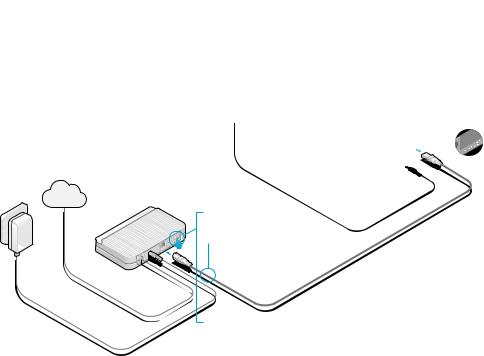
Chapter 2 |
|
2. 1. Position Your Router
•The Product should not be located where it will be exposed to moisture or excessive heat.
•Place the router in a location where it can be connected to the various devices as well as to a power source.
•Make sure the cables and power cord are safely placed out of the way so they do not create a tripping hazard.
•The router can be placed on a shelf or desktop.
•Keep away from the strong electromagnetic radiation and the device of electromagnetic sensitive.
2. 2. Connect Your Router
1. Follow the steps below to connect your router.
If your Internet connection is through an Ethernet cable from the wall instead of through a DSL / Cable / Satellite modem, connect the Ethernet cable directly to the router’s Internet port, then follow step 4 and 5 to complete the hardware connection.
Power Adapter
Router |
4 |
Internet
1
|
|
2 |
|
Power Adapter |
Modem |
|
|
3 |
1 ) |
Turn off the modem, and remove the backup battery if it has one. |
|
2 ) |
Connect the modem to the Internet port on your router with an Ethernet cable. |
|
3 ) |
Turn on the modem, and then wait about 2 minutes for it to restart. |
|
7
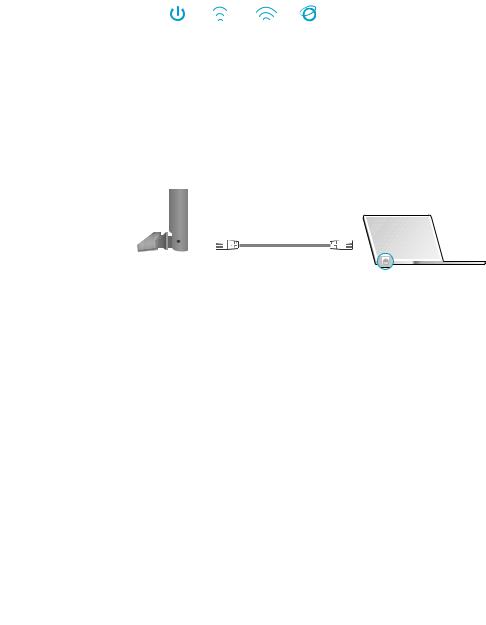
Chapter 2 |
Smart Device |
4 ) Turn on the router.
5 ) Verify that the hardware connection is correct by checking these LEDs.
Power |
2.4GHz |
5GHz |
Internet |
On |
On |
On |
On |
 Tips: If 2.4GHz LED and 5GHz LED are off, press the WPS/Wi-Fi On/Off button for about 2 seconds, and then check the LEDs again in a few seconds.
Tips: If 2.4GHz LED and 5GHz LED are off, press the WPS/Wi-Fi On/Off button for about 2 seconds, and then check the LEDs again in a few seconds.
2. Connect your computer to the router.
• Method 1: Wired
Turn off the Wi-Fi on your computer and connect the devices as shown below.
Ethernet Cable
• Method 2: Wirelessly
1 ) Find the SSID (Network Name) and Wireless Password/PIN printed on the label at the bottom of the router.
2 ) Click the network icon of your computer or go to Wi-Fi Setting of your smart device, and then select the SSID to join the network.
|
|
|
|
|
Computer |
|
|
|
|
|
|
|
|
|
|
|
Smart Device |
||
|
|
|
|
|
Connections are available |
|
|
|
|
|
|
|
|
|
|
< Settings |
Wi-Fi |
||
|
|
|
|
|
|
|
|
|
|
|
|
|
|
|
|
|
|
|
|
|
|
|
|
|
|
|
|
|
|
|
|
|
|
|
|
|
|
|
|
|
|
|
|
|
|
|
|
|
|
|
|
|
|
|
|
Wi-Fi |
|
|
|
Wireless Network Connection |
|
|
|
|
|
|
|
|
|
|
|
|
|
||||||
|
|
|
|
|
|
|
|
|
|
|
|
|
|
|
|
|
|
|
|
|
|
|
|
|
|
|
|
|
|
|
|
|
|
|
|
CHOOSE A NETWORK... |
|||
TP-LINK_XXXX |
|
|
|
|
|
|
|
|
|
|
|||||||||
|
|
|
|
|
|
|
|
||||||||||||
|
|
|
|
|
|
|
|
|
|
|
|
|
|
||||||
TP-LINK_XXXX_5G |
|
|
|
|
|
|
|
|
|
|
TP-LINK_XXXX |
|
|
||||||
|
|
|
|
|
|
|
|
|
|
|
|
||||||||
√ Connect automatically |
Connect |
|
|
|
|
|
|
||||||||||||
|
|
|
|
|
|||||||||||||||
|
|
|
|
TP-LINK_XXXX_5G |
|
|
|||||||||||||
|
|
|
|
|
|
||||||||||||||
|
|
|
|
|
|
|
|
|
|
|
|
|
|
|
|
|
|
||
|
|
|
|
|
|
|
|
|
|
|
|
|
|
|
|
Other... |
|
|
|
|
|
|
|
|
|
|
|
|
|
|
|
|
|
|
|
|
|
|
|
|
|
|
|
|
|
|
|
|
|
|
|
|
|
|
|
|
|
|
|
• Method 3: Use the WPS button
Wireless devices that support WPS, including Android phones, tablets, most USB network cards, can be connected to your router through this method. (WPS is not supported by iOS devices.)
 Note:
Note:
The WPS function cannot be configured if the wireless function of the router is disabled. Also, the WPS function will be disabled if your wireless encryption is WEP. Please make sure the wireless function is enabled and is configured with the appropriate encryption before configuring the WPS.
8

Chapter 2 |
Close to |
1.Tab the WPS icon on the device’s screen.
2.Immediately press the WPS button on your router.
Close to
9

Chapter 3
Log into Your Router
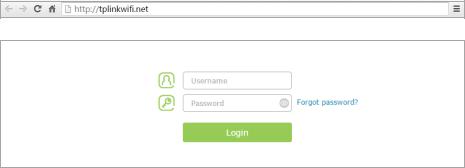
Chapter 3 |
Log into Your Router |
With a Web-based utility, it is easy to configure and manage the rouer. The Web-based utility can be used on any Windows, Macintosh or UNIX OS with a Web browser, such as Microsoft Internet Explorer, Mozilla Firefox or Apple Safari.
Follow the steps below to log into your router.
1.Set up the TCP/IP Protocol in Obtain an IP address automatically mode on your computer.
2.Visit http://tplinkwifi.net, and log in with the username and password you set for the router. The default one is admin for both username and password.
 Note:
Note:
If the login window does not appear, please refer to FAQ Section.
11

Chapter 4
Set Up Internet Connection
This chapter introduces how to connect your router to the Internet. The router is equipped with a web-based Quick Setup wizard. It has necessary ISP information built in, automates many of the steps and verifies that those steps have been successfully completed. Furthermore, you can also set up an IPv6 connection if your ISP provides IPv6 service.
This chapter contains the following sections:
•Use Quick Setup Wizard
•Manually Set up Your Internet Connection
•Set Up an IPv6 Internet Connection

Chapter 4 |
Set Up Internet Connection |
4. 1. Use Quick Setup Wizard
The Quick Setup Wizard will guide you through the process to set up your router.
 Tips:
Tips:
If you need the IPv6 Internet connection, please refer to the section of Set Up an IPv6 Internet Connection.
Follow the steps below to set up your router.
1.Visit http://tplinkwifi.net, and log in with the username and password you set for the router.
2.Click Quick Setup on the top of the page. Then follow the step-by-step instructions
to connect your router to the Internet.
 Note:
Note:
During the quick setup process:
•If you are not sure of the Internet Connection Type, please click Auto Detect or contact your ISP for Internet connection information.
•If you have changed the preset wireless network name (SSID) and wireless password, all your wireless devices must use the new SSID and password to connect to the router.
4. 2. Manually Set up Your Internet Connection
In this part, you can check your current Internet connection settings. You can also modify the settings according to the service information provided by your ISP.
Follow the steps below to check or modify your Internet connection settings.
1.Visit http://tplinkwifi.net, and log in with the username and password you set for the router.
2.Go to Basic > Internet.
3.Select your Internet connection type from the drop-down list.
 Note:
Note:
If you are unsure of what your connection type is, click Auto Detect. Since different connection types need different cables and connection information, you can also refer to the demonstrations in Step 4 to determine your connection type.
4.Follow the instructions on the page to continue the configuration. Parameters on the figures are just used for demonstration.
1 ) If you choose Dynamic IP, you need to select whether to clone the MAC address or not. Dynamic IP users are usually equipped with a cable TV or fiber cable.
13
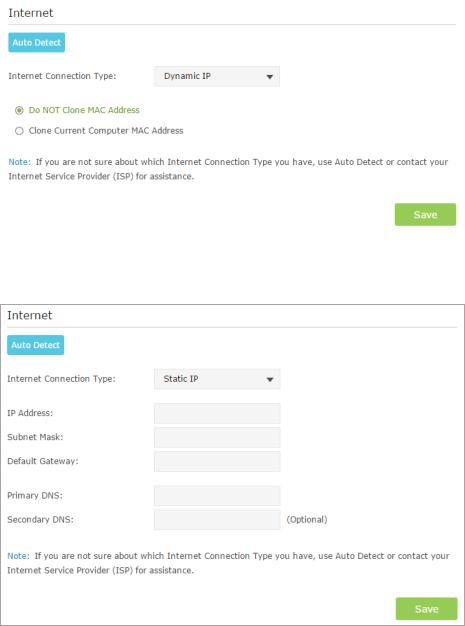
Chapter 4 |
Set Up Internet Connection |
|
|
|
|
|
|
|
2 ) If you choose Static IP, enter the information provided by your ISP in the corresponding fields.
3 ) If you choose PPPoE, enter the username and password provided by your ISP. PPPoE users usually have DSL cable modem.
14
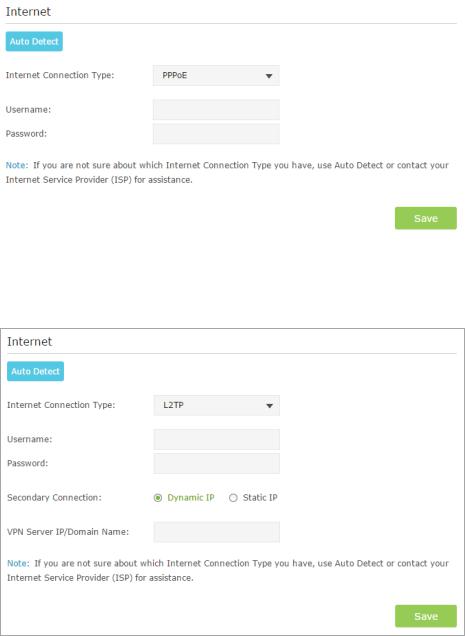
Chapter 4 |
Set Up Internet Connection |
|
|
|
|
|
|
|
4 ) If you choose L2TP, enter the username and password and choose the Secondary Connection provided by your ISP. Different parameters are needed according to the Secondary Connection you have chosen.
5 ) If you choose PPTP, enter the username and password, and choose the Secondary Connection provided by your ISP. Different parameters are needed according to the Secondary Connection you have chosen.
15
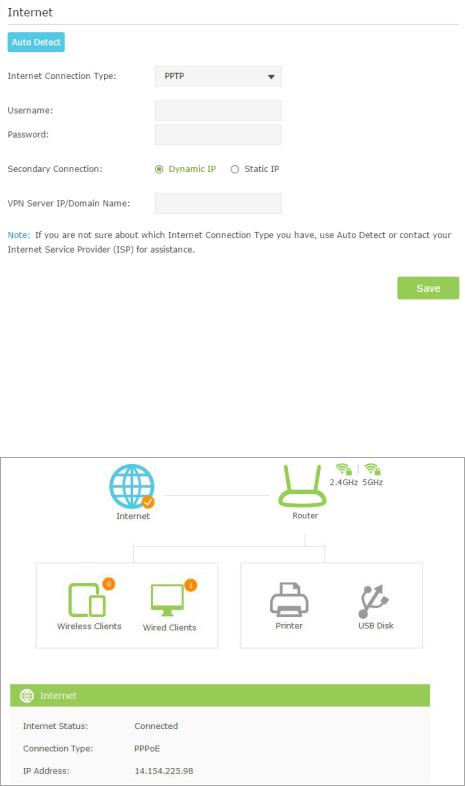
Chapter 4 |
Set Up Internet Connection |
|
|
|
|
|
|
|
5. Click Save. To check your Internet connection, click Network Map on the left of the page.
 Note:
Note:
It may take 1-2 minutes to make the settings valid.
6.After the connection succeeds, the screen will display as follows. Here we take PPPoE as an example.
 Tips:
Tips:
1.If your Internet connection type is BigPond Cable, please go to Advanced > Network > Internet to set your router.
2.If you use Dynamic IP and PPPoE and you are provided with any other parameters that are not required on the page, please go to Advanced > Network > Internet to complete the configuration.
3.If you still cannot access the Internet, refer to the FAQ for further instructions.
16
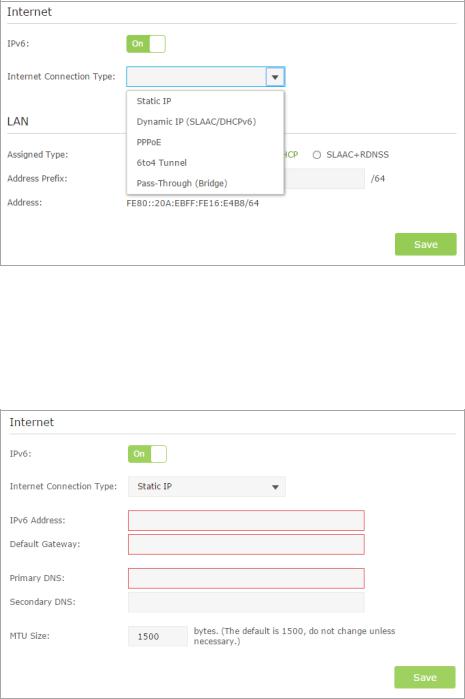
Chapter 4 |
Set Up Internet Connection |
4. 3. Set Up an IPv6 Internet Connection
Your ISP provides information about one of the following IPv6 Internet connection types: PPPoE, Dynamic IP(SLAAC/DHCPv6), Static IP, 6to4 tunnel, Pass-Through (Bridge).
1.Visit http://tplinkwifi.net, and log in with the username and password you set for the router.
2.Go to Advanced > IPv6. Select the Internet connection type provided by your ISP.
 Tips:
Tips:
If you do not know what your Internet connection type is, contact your ISP or judge according to the already known information provided by your ISP.
3.Fill in information as required by different connection types. Red blanks must be filled in.
1 ) Static IP: Fill in blanks and click Save.
17
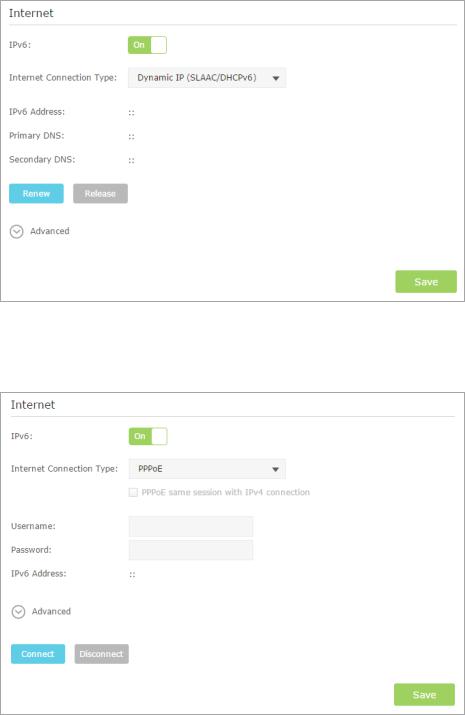
Chapter 4 |
Set Up Internet Connection |
2 ) Dynamic IP(SLAAC/DHCPv6): Click Advanced to do more configuration if your ISP requires. Click Save and then click Renew to finish the configuration.
3 ) PPPoE: Fill in the Username and Password. Click Advanced to do more configuration if your ISP requires. Click Save and then click Connect to finish the configuration.
4 ) 6to4 Tunnel: An IPv4 Internet connection type is a prerequisite for this connection type (Manually Set up Your Internet Connection). Click Advanced to do more configuration if your ISP requires. Click Save and then click Connect to finish the configuration.
18
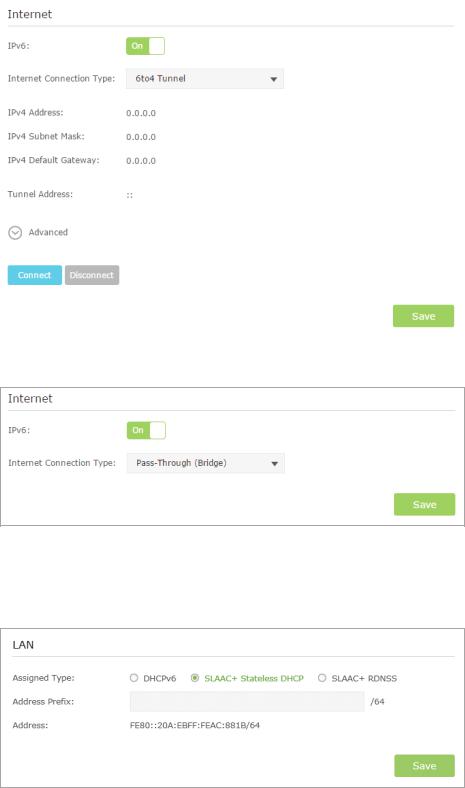
Chapter 4 |
Set Up Internet Connection |
||
|
|
|
|
|
|
|
|
5 ) Pass-Through (Bridge): Click Save and skip to step 6.
4. Configure LAN ports. Windows users are recommended to choose from the first two types. Fill in Address Prefix provided by your ISP, and click Save.
 Tips:
Tips:
Find Help on the management interface to know more about items.
5.Click Status to check whether you have successfully set up an IPv6 connection. The following figure is an example of a successful PPPoE configuration.
19
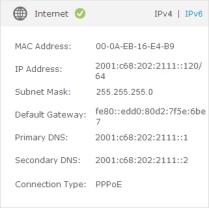
Chapter 4 |
|
Set Up Internet Connection |
|
|
|
|
|
|
 Tips:
Tips:
Visit the FAQ if there is no Internet connection.
20

Chapter 5
Guest Network
This function allows you to provide Wi-Fi access for guests without disclosing your main network. When you have guests in your house, apartment, or workplace, you can create a guest network for them. In addition, you can customize guest network options to ensure network security and privacy.
This chapter contains the following sections:
•Create a Network for Guests
•Customize Guest Network Options
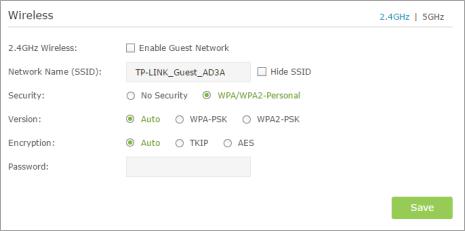
Chapter 5 |
Guest Network |
5. 1. Create a Network for Guests
1.Visit http://tplinkwifi.net, and log in with the username and password you set for the router.
2.Go to Advanced > Guest Network. Locate the Wireless section.
3.Create a guest network according to your needs.
1 ) Enable 2.4GHz Wireless network or 5GHz Wireless network.
 Note:
Note:
Guest network and WDS cannot be enabled at the same time. If WDS was enabled, disable it at Advanced > System Tools > System Parameters.
2 ) Customize the SSID. Don‘t select Hide SSID unless you want your guests to manually input the SSID for guest network access.
3 ) Set Security to WPA/WPA2 Personal, keep the default Version and Encryption values, and customize your own password.
4. Click Save. Now your guests can access your guest network using the SSID and password you set!
 Tips:
Tips:
To view guest network information, go to Advanced > Status and locate the Guest Network section.
22

Chapter 5 |
Guest Network |
5. 2. Customize Guest Network Options
1.Visit http://tplinkwifi.net, and log in with the username and password you set for the router.
2.Go to Advanced > Guest Network. Locate the Settings section.
3.Customize guest network options according to your needs.
•Allow guests to see each other
Select this checkbox if you want to allow the wireless clients on your guest network to communicate with each other via methods such as network neighbors and Ping.
•Allow guests to access my local network
Select this checkbox if you want to allow the wireless clients on your guest network to communicate with the devices connected to your router’s LAN ports or main network via methods such as network neighbors and Ping.
4. Click Save. Now you can ensure network security and privacy!
 Tips:
Tips:
To view guest network information, go to Advanced > Status and locate the Guest Network section.
23

Chapter 6
Parental Controls
This function allows you to block inappropriate, explicit and malicious websites, and controls access to specified websites at specified time.
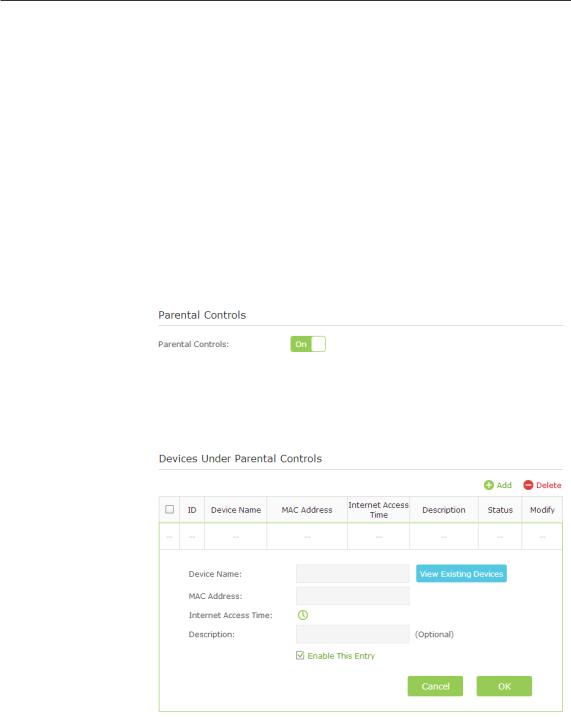
Chapter 6 Parental Controls
I want to: |
Control the times of day my children or other home network |
|
|
users are allowed to access the Internet and even types of |
|
|
websites they can visit. |
|
|
For example, I want to allow my children’s devices (e.g. a |
|
|
computer or a tablet) to access only www.tp-link.com and |
|
|
Wikipedia.org from 18:00 (6PM) to 22:00 (10PM) at the weekend |
|
|
and not other times. |
|
How can I |
1. |
Visit http://tplinkwifi.net, and log in with the username and |
do that? |
|
password you set for the router. |
|
2. |
Go to Advanced > Parental Controls and enable Parental |
|
|
Controls. |
|
|
|
|
|
|
|
3. |
Click Add. And then Click View Existing Devices, and select |
|
|
the access device. Or, input the Device Name and MAC |
|
|
Address manually. |
|
|
|
|
|
|
4.Click the  icon to set the Internet Access Time. Drag the cursor over the appropriate cell(s) and click OK.
icon to set the Internet Access Time. Drag the cursor over the appropriate cell(s) and click OK.
25

Chapter 6 |
Parental Controls |
|
|
|
|
5.Enter a Description for the entry. Keep the Enable This Entry checkbox selected. Click OK.
6.Select Whitelist as the restriction policy.
 Tips:
Tips:
1.With Blacklist selected, the controlled devices cannot access any websites containing the specified keywords during the Internet Access Time period.
2.With Whitelist selected, the controlled devices can only access websites containing the specified keywords during the Internet Access Time period.
7.Click  . Enter a keyword or a website and click Save.
. Enter a keyword or a website and click Save.
You can add up to 32 keywords for either Blacklist orWhitelist. Below are some sample entries to allow access.
•Enter a web address (e.g. wikipedia.org) or a web address keyword (e.g. wikipedia) to only allow or block access to the websites containing that keyword.
•Specify the domain suffix (eg. .edu or .org) to allow access only to the websites with that suffix.
•If you wish to block all Internet browsing access, do not add any keyword to the Whitelist.
26
